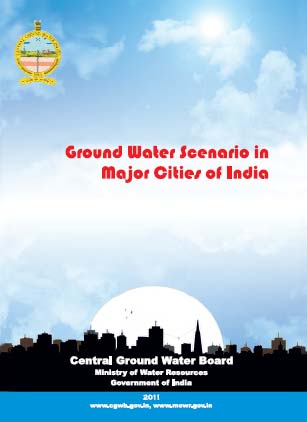 It covers varying groundwater scenarios in the country including the highly developed metros, the hilly region, the coastal cities, the cities tapping unconsolidated and hard rock aquifers. The report briefly describes the administrative set up, status of water supply and demand, groundwater scenario, feasibility of rainwater harvesting and groundwater development strategy.
It covers varying groundwater scenarios in the country including the highly developed metros, the hilly region, the coastal cities, the cities tapping unconsolidated and hard rock aquifers. The report briefly describes the administrative set up, status of water supply and demand, groundwater scenario, feasibility of rainwater harvesting and groundwater development strategy.
It is an updated version of an earlier report on “Groundwater in urban environment in India” (2000). Since then, groundwater regime, urban demography and water demand have changed enormously. This report will form a scientific base for an in-depth understanding of urban groundwater system including aquifer geometry, water level behavior and groundwater quality. The possibility of artificial recharge to rejuvenate the urban aquifers has also been discussed.
Groundwater plays a very important role in meeting the water demand of Indian cities. There are three types of situations (i) where the entire water supply is met from surface water (ii) where the entire water supply is met from groundwater (iii) where there is a mixed supply, a combination of both. The first option is no longer existent in absence of adequate and consistent supplies. The option of own source is gaining ground and it invariably taps groundwater. Furthermore, industries too have a network of their own wells.
Thus the groundwater regime beneath cities is being adversely affected. Where there is mixed supply, generally the core part of the city may have surface water supply and the extension areas depend on groundwater supply. This results in a groundwater mound in the central part and declining trend in the peripheries. In the case of the third situation, extraction creates a groundwater trough below the city. Besides this, the ever increasing sewerage and industrial waste are polluting the fresh groundwater.
The report discusses the various options for sustainable water supply in urban India like augmentation of water supply through rainwater harvesting, conservation and groundwater recharge. This supported by groundwater regulation would enable overall improvement of water resources in the cities. In addition there is need for demand management, which the urban policy makers have to emphasize.
Though there are novel efforts of the government agencies, what are equally important are innovative measures promoted by private and individuals in cities to augment water supply. The urban centers have to learn from the successful experiences demonstrated by government and NGOs to augment water supply. A decentralised approach, with coordination among the state, private sector and civil society, is needed for evolving better water supply options in urban India.
There is also substantial potential for demand side management options. Unaccounted water in urban areas exceeds fifty per cent which if saved can substantially meet the justified water demand. Conservation, which is less expensive and more environmentally sound than new investment, would minimize the future capital requirements. Water conservation can be achieved through more effective maintenance mechanisms, which can help to overcome the problems of pilferage and leakage. Demand management can be achieved through financial incentives and technological interventions.
The imperative need is to have sound planning strategies for managing, protecting and conserving the urban aquifer systems for sustainable extraction of groundwater over a longer period.